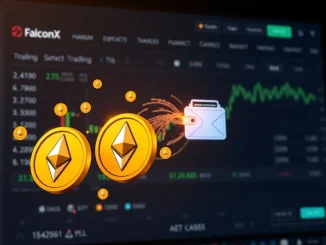
Are you an Ethereum holder? The stability of your digital assets might be facing an unexpected challenge. Recent reports highlight a concerning spike in wETH borrowing costs, signaling potential turbulence for Ethereum Stability in the short term. This isn’t just a minor blip; it’s a structural vulnerability in the decentralized finance (DeFi) ecosystem that could impact ETH’s price trajectory and the broader crypto market trends.
Understanding the Alarming Rise in wETH Borrowing Costs
The crypto market is buzzing with warnings about Ethereum’s immediate future, largely due to a significant surge in borrowing costs for wrapped Ether (wETH). Markus Thielen, head of research at 10x Research, points to a growing fragility within Ethereum’s ecosystem. He highlights two critical factors: technical overvaluation and strained liquidity across major DeFi platforms like Aave. The core issue? The variable wETH Borrowing Costs have skyrocketed, squeezing profit margins for lenders and creating a precarious environment for borrowers. This could lead to a ‘meaningful unwinding’ of positions, potentially triggering cascading liquidations or strategic exits that destabilize ETH’s price.
For context, Aave’s wETH utilization rate, for instance, jumped from 86% to 95% since early July. This reflects heightened demand for borrowing that has outpaced available liquidity, directly contributing to the elevated borrowing costs. Such imbalances are a red flag for market participants.
The Domino Effect: How DeFi Lending Risks Impact Ethereum Stability
The mechanics of wETH are crucial to understanding these DeFi Lending Risks. wETH is essentially ETH ‘wrapped’ to enable its use across various DeFi protocols. Historically, arbitrage opportunities helped align wETH and ETH prices, acting as a self-correcting mechanism. However, as borrowing demand wanes and costs rise, these arbitrage opportunities are eroding. This means the vital link stabilizing wETH’s value relative to its underlying ETH collateral is weakening.
Thielen warns that over 90% of ETH loans carry variable interest rates, leaving borrowers highly exposed to sudden cost hikes. If this imbalance persists, a mass unwinding of wETH positions could accelerate selling pressure on ETH as wrapped tokens are converted back to their native form during liquidations. This interconnectedness means a problem in one part of DeFi can quickly ripple through the entire Ethereum Stability framework, potentially leading to broader market contagion.
Navigating ETH Price Volatility: What Investors Need to Know
Despite the immediate concerns, navigating ETH Price Volatility requires a balanced perspective. While the short-term outlook presents challenges, Thielen remains optimistic about Ethereum’s long-term trajectory. Historical data from CoinGlass offers some seasonal insights:
- Q3 has typically been the second-worst-performing quarter for Ether since 2013, averaging an 8.19% return.
- Conversely, Q4 usually delivers the strongest results, averaging 22.59%.
These historical trends suggest a potentially more favorable environment for ETH after September, provided the market can absorb current pressures without systemic fallout. However, the analyst emphasizes that this unwinding scenario is a ‘meaningful’ risk, not a certainty, contingent on continued contraction in borrowing demand. Investors must stay vigilant and monitor key metrics.
Beyond the Immediate Threat: Long-Term Crypto Market Trends for Ethereum
The current situation serves as a critical test for the Ethereum network’s resilience, especially as institutional adoption of tokenized assets continues to grow across the broader Crypto Market Trends. Thielen’s analysis highlights the inherent fragility within synthetic token markets, where liquidity mismatches and variable rate structures can significantly amplify volatility. For market participants, it’s crucial to closely monitor wETH Borrowing Costs and ETH’s price correlation for early stress signals.
This period underscores the importance of conducting independent research. The potential unwinding scenario could expose portfolios to unexpected losses stemming from DeFi’s complex and interconnected mechanisms. While the long-term outlook for Ethereum remains strong, understanding these immediate crypto market trends is vital for informed decision-making.
In conclusion, while Ethereum’s long-term prospects remain bright, the immediate future presents significant challenges driven by surging wETH Borrowing Costs and inherent DeFi Lending Risks. The interconnected nature of the decentralized finance ecosystem means that vulnerabilities, such as high utilization rates and variable interest loans, can quickly amplify into broader ETH Price Volatility. Investors are urged to remain cautious, monitor key indicators like wETH borrowing rates, and conduct thorough independent research. Navigating these turbulent waters requires a clear understanding of both the immediate threats to Ethereum Stability and the long-term potential that continues to make it a cornerstone of the crypto market.
Frequently Asked Questions (FAQs)
Q1: What is wETH and why are its borrowing costs spiking?
A1: wETH, or wrapped Ether, is a tokenized version of ETH that allows it to be used across various DeFi protocols. Its borrowing costs are spiking due to high demand and utilization rates on lending platforms like Aave, where demand for borrowing is outstripping available liquidity.
Q2: How do variable-rate loans contribute to Ethereum’s short-term risk?
A2: Over 90% of ETH loans in DeFi use variable interest rates. This means borrowers are exposed to sudden and significant cost increases if market conditions change, potentially leading to forced liquidations or strategic exits that could depress ETH’s price.
Q3: What does a ‘meaningful unwinding’ mean for ETH price?
A3: A ‘meaningful unwinding’ refers to a scenario where borrowers close their wETH positions en masse due to rising costs. This can lead to wETH being converted back to ETH and then sold, increasing selling pressure on the underlying ETH asset and potentially causing its price to drop.
Q4: Is Ethereum’s long-term outlook still positive despite these risks?
A4: Yes, analysts like Markus Thielen remain optimistic about Ethereum’s long-term trajectory. Historical data suggests Q4 is typically a strong quarter for ETH. The current risks are considered short-term structural vulnerabilities rather than fundamental flaws that undermine its long-term potential.
Q5: What should investors do to mitigate risks related to wETH borrowing costs?
A5: Investors should closely monitor wETH borrowing rates, observe ETH’s price correlation, and conduct independent research into the health of DeFi lending protocols. Understanding the interconnected mechanisms of synthetic token markets is crucial to managing potential portfolio exposure.



